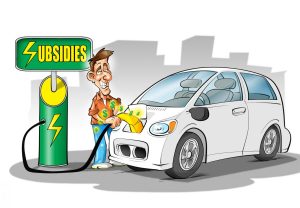Guest Post by Eric Peters

Toyota just announced it would be “investing” $500 million in Uber, the ride-sharing service, to further development of “autonomous” – that is, automated – vehicles and “mobility as a service.”
The reason Toyota and several other car manufacturers are making these “investments” is for one reason only: They know they cannot continue to sell cars for very much longer because people increasingly cannot afford to own them.
For three reasons.
First, the accretion of cost due to mandates that are becoming – and arguably already are – economically unsupportable.
Adding a single catalytic converter to a car back in ’75 (the first year for them) added a couple hundred bucks, maybe, to the price of a new car – and reduced harmful emissions by double digits. Adding four cats and O2 sensors plus direct injection (and a separate port fuel-injection system to deal with the problems created by the DI system) adds probably several thousand dollars to a car vs. a throttle body (TBI) injection system for reductions in pollution you need a 400x power microscope to see.
The government is now insisting on essentially zero emissions – regardless of cost. And no matter that a car which emits almost zero emissions isn’t a threat to anyone’s health.
Cars are going to get even more expensive if the government insists they average 50-plus MPG (Trump is trying to prevent this) which would have the same effect as a general electric car mandate because adding electric cars – which don’t burn any gas – to a car company’s model lineup makes it more feasible to sell cars that do burn gas but don’t get 50-plus MPG, by improving the car company’s overall “fleet average” fuel economy figures.
Electric cars also emit no carbon dioxide – which the government now characterizes as an “emission” subject to regulation – even though it is an irrelevance as regards air quality or public health. Nonetheless, the only way to reduce C02 emissions is to build fewer IC cars – and more electric cars.
But electric cars are much to expensive for most people to buy, so they have to be given away at a net loss per car. The problem with that – for the car companies – is obvious.
Which brings us to the second reason for the desperate rush toward “mobility as a service.”
In addition to the costs imposed by government fatwa, there is the rip-tide-like effect on the cost of cars generally of a population that largely loves debt and living beyond its means combined with a mania for whatever’s New . . . with New things (mostly electronic things) becoming available literally all the time.
The problem is these things cost money – and most people haven’t got it. Most people aren’t earning more of it, that is – enough to keep pace with the increasing cost of new cars equipped with all the Newest and Latest things.
So they finance. And the problem with that – when it comes to cars – is that cars are rapidly depreciating consumer appliances. You can only finance so far. Or rather, so long. Seven – maybe eight years, being the outer limit because at that point, no matter what you started out with, it will be worth less than half its original purchase price.
There isn’t much incentive to keep making payments on a thing that is worth less than what you still owe on the balance due – with years of payments yet to make. And even less incentive to make a loan on such an item – something lenders understand very well.
Thirdly, there is the problem of the peripheral costs of car ownership. Insurance costs are skyrocketing because cars have become too complex, fragile and more disposable.
While they don’t need the regular tuning-up and other minor adjustments cars once needed, when they do need work, it is often extremely expensive – because of the complexity of the components and the specialized diagnostic equipment and highly-trained (and highly expensive) technicians needed to service them competently.
They are also easily damaged. Front and rear clips are made of plastic; hoods and fenders of extremely thin gauge metal (often, aluminum) in order to shave weight and increase mileage (to comply with government MPG fatwas) with the result being that what used to be minor fender-benders are now major accidents, in terms of repair costs – and these costs are necessarily being reflected in insurance costs. While the insurance mafia is despicable – any business that uses the government to force people to buy its services is despicable – one cannot blame them for adjusting premium costs to reflect repair costs.
Cars now have so many air bags – the average new car has at least six – that the chances of the car being declared a total loss (economically unrepairable) in the event of a relatively minor – and otherwise repairable – accident are high. It can cost several thousand dollars to replace just two air bags – and all the related interior parts destroyed when the air bags go off. This is before one adds up the cost to repair damaged body panels. Most insurance companies will write-off a car as a total loss if the estimated cost to fix it exceeds 50 percent of its retail value.
Getting to 50 percent isn’t hard when a car is say four or five years old, worth 60 percent what you paid for it – and the wreck you just had will take $10,000 to repair (a third of that cost being the cost to replace the air bags that went off).
A car that cost $35,000 when it was new – the average purchase price of a 2018 model car – is effectively worthless after just a few years or a fairly minor accident. It is a lot of money to just throw away.
These synergies – the cost of government mandates, the debt-financed upticking in the average price of cars plus the increasing peripheral costs of car ownership – are headed in an obvious direction:
Which is what “mobility as a service” amounts to. People who cannot afford to buy cars anymore will rent them instead. And not even rent the cars, per se.
They will buy rides.
There is admittedly an element of convenience – for city people, perhaps (those who aren’t city people will inevitably have to wait for their ride to appear; no more just getting in and going) and it is without doubt a way to make “transportation” more “affordable.”
But it is also a depreciation of something important.
When you own your car, you are free to take a drive wherever you like, however you like, as long you like – and at the spur of the moment, if you like. These automated ride-sharing cars will turn you into a passenger in a bus for one. You will have ceded control over your movements – when not on foot – to a collective, which will decree when and how you move.
Loss of ownership is also exactly like having to “share” your living space with other people. A community car is like a community bathroom, roommates eating your food and other such delights of the impecunious. It’s okay when you’re 21 and temporary. But when you’re 41 – and it’s permanent . . . not so much. 
“Mobility as a service” is a diminishment. It is part of the proletarianization of the American people.
It’s tragic. More so because it’s unnecessary.
If it weren’t for the government fatwas and a gadget-addled, debt-addicted populace, there would be brand-new cars most people could stroke a check for – or which only took three or four years to pay off, as was once the case – though no one remembers that anymore, either.
Just like they don’t remember what it was like to be able to ride a motorcycle without a helmet, argue with a cop without risking death and board an airplane without a prostate check.







When my wifes’s car is due for a trade-in, I’m going to sell or trade in both our vehicles for a truck she can drive so we can cut costs (ie, one vehicle, one insurance bill, one tag). I have a scooter but the Jews have not got the law to require insurance yet.
This is a faulty argument. If it costs so much money to purchase a car, and the emission costs, and they depreciate, and they are easily damaged – how does ‘providing mobility’ make the transportation any cheaper? It doesn’t.
Most professionals / office workers / warehouse workers / trades people – drive to their jobs. This isn’t going to change. Maybe on dedicated highways – in warm states: California / Arizona / Utah / … these cars can ‘work’. They certainly aren’t going to work here in Minnesota with snow and ice, at least 4 months a year.
I have a 2018 Subaru with ‘Eyesight’. It will tell you if you’re over the lane markers (lines on the road). However, if it’s a hard rain – the Eyesight shuts down. I assume this is the same for ‘autonomous’ vehicles. So your car shuts down in a rain storm??
I have one with that too. I about crapped the first time it stopped in a rainstorm. What ticks me off is that the cruise doesn’t work if the Eyesight isn’t operative. This stuff is faaaaaar from perfected in my opinion. It is a really great idea and it saved at least one stupid kid who literally leapt into the middle of the street in front of me. One big drawback is that when I am not in the Subaru I have to remember that there are no beeps or warnings for people in my blind spot etc. One night the warning went off and stayed on and I could not see anything but trusted it. Sure enough some elderly woman who probably shouldn’t drive had her lights off and was glued to my blind spot.
70% is the point they total out a car, not 50.
You know we’ll really be screwed when they disallow the older cars still in use. No way?
Don’t bet on it, these days, or in the future sometime.
Weed out the simpler designs, without the electronics, tracking devices, and with unacceptable fuel MPG performance.
Cash for clunkers forced turn ins to have their engines filled with fluids to prevent salvage for reuse, if not mistaken.
Yes, like other electronics items segued from repairable, reliable tanks into disposables because major repairs cost too much in parts and labor, the trend with cars is notable.
Twenty years ago, who would have thought charities would spring up as places to donate an unwanted car? Give away your old car? Our Grand Dad’s are shaking their heads in the afterlife.
Older used cars are our frugal solution, but a threat to the fatwa trend.
The newer units have their advantages, I’ll concede.
From an economics standpoint,
I fall into the clean, older models as a preference.
The times, they are a-changing.
Too damn fast, before our eyes.